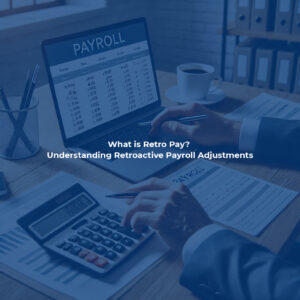In the world of payroll and employee compensation, mistakes can happen. Whether due to administrative errors, delayed raises, or payroll system glitches, employees sometimes receive incorrect wages. When this happens, employers must rectify the situation by issuing retro pay, or retroactive pay. But what exactly is retro pay, and how does it impact your business? Let’s break it down.
What is Retro Pay?
Retro pay refers to the compensation owed to an employee when they were underpaid in a previous pay period. It is a correction to past wages that were not properly calculated due to various reasons. Retro pay ensures that employees receive the full amount they were entitled to, even if the correction occurs later.
Common Reasons for Retro Pay
Employers may need to issue retro pay for several reasons, including:
-
Salary Increases or Promotions: If an employee receives a raise or promotion but the new pay rate is not updated in time, they will need retro pay to cover the difference.
-
Payroll System Errors: Technical issues in payroll software can sometimes lead to incorrect pay calculations.
-
Misclassification of Employees: If an employee was mistakenly classified at a lower pay grade or as a different type of worker (e.g., contractor vs. full-time employee), they may be owed retroactive wages.
-
Overtime Miscalculations: If an employer fails to account for overtime hours properly, retro pay may be required to compensate for the unpaid overtime.
-
Union or Contract Adjustments: Retro pay is common in industries with collective bargaining agreements, where wage changes can be applied retroactively based on negotiations.
How to Calculate Retro Pay
Calculating retro pay depends on the type of error and the length of time it covers. Here’s a basic example:
Scenario: An employee earns $20 per hour and was given a raise to $22 per hour effective January 1st. However, payroll wasn’t updated, and they continued receiving $20 per hour for two pay periods (80 hours total).
Retro Pay Calculation:
-
Correct pay rate: $22/hour
-
Amount received: $20/hour
-
Difference: $2/hour
-
Total retro pay owed: $2 x 80 hours = $160
Employers must ensure that all applicable taxes, benefits, and deductions are properly applied to retro pay calculations.
How Does Retro Pay Affect Payroll Processing?
Handling retro pay requires careful payroll adjustments to ensure compliance with labor laws and tax regulations. Employers should:
-
Identify the Pay Discrepancy: Determine when and why the underpayment occurred.
-
Calculate the Amount Owed: Factor in all hours worked and applicable pay adjustments.
-
Process the Payment: Issue retro pay through the company’s payroll system while ensuring proper tax withholding.
-
Communicate with Employees: Transparency is key; inform employees about the retroactive payment to avoid confusion.
Retro Pay vs. Back Pay: What’s the Difference?
Retro pay and back pay are often confused, but they are different:
-
Retro Pay refers to adjustments made due to payroll mistakes, late pay increases, or miscalculations.
-
Back Pay is compensation owed due to a legal dispute, wrongful termination, or violation of labor laws.
How NetPEO Can Help
Managing payroll errors and retro pay adjustments can be time-consuming and complex. That’s where NetPEO comes in. As a trusted PEO and payroll outsourcing partner, we help businesses streamline payroll processing, minimize compliance risks, and ensure employees are compensated accurately.
With NetPEO, you can: ✅ Avoid payroll errors that lead to retro pay issues. ✅ Ensure compliance with federal and state labor laws. ✅ Save time with expert payroll management services. ✅ Focus on growing your business while we handle payroll complexities.
Get Payroll Right the First Time
If your business struggles with payroll processing or wants to prevent costly retro pay mistakes, NetPEO is here to help. Contact us today for a free consultation and learn how our payroll solutions can keep your employees paid accurately and on time.

